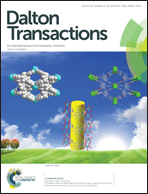Towards a better understanding of honeycomb alternating magnetic networks†
Abstract
Two new two-dimensional homometallic compounds {[M2(bpm)(ox)2]n·5nH2O} with M = Co(II) (1) and Zn(II) (2) and the mononuclear nickel(II) complex [Ni(bpm)2(ox)]·2H2O (3) [bpm = 2,2′-bipyrimidine and ox = oxalate] have been prepared and structurally characterized. 1 and 2 are isostructural compounds whose structures are made up of oxalate-bridged M(II) cations cross-linked by bis-bidentate bpm molecules to afford a honeycomb layered network extending in the crystallographic ab plane. The layers are eclipsed along the crystallographic c axis and show graphitic-like interactions between the bpm rings. The three-dimensional supramolecular network deriving from such interactions is characterized by hexagonal-shaped channels extending in the same direction. Each M(II) ion in 1 and 2 is tris-chelated with four oxygen atoms from two oxalate groups and two bpm-nitrogen atoms building a distorted octahedral surrounding. The reduced values of the angles subtended by the bis-chelating bpm [77.69(8) (1) and 76.59(8)° (2)] and oxalate [79.69(6) (1) and 80.01(5)° (2)] are the main factors accounting for this distortion. The values of the metal–metal separation through bridging bpm are 5.6956(7) (1) and 5.7572(9) Å (2), whereas those across the bis-bidentate oxalate are 5.4306(4) (1) and 5.4058(5) Å (2). 3 is a neutral mononuclear nickel(II) complex where each metal ion is six-coordinate with four nitrogen atoms from two bpm ligands in a cis arrangement and two oxalate-oxygen atoms building a somewhat distorted octahedral surrounding. The values of the angles subtended at the nickel(II) ion by bpm and oxalate are 78.14(4) and 80.95(5)°, respectively. The magnetic properties of 1 have been investigated in the temperature range 1.9–295 K. They are typical of an overall antiferromagnetic coupling with a maximum of the magnetic susceptibility at 22.0 K. The analysis of the susceptibility data of 1 through an effective spin Hamiltonian allowed a satisfactory simulation in the temperature range 10–295 K with the best-fit parameters λ = −110 cm−1, α = 1.1, |Δ| = 400 cm−1, Jox = −11.1 cm−1 and Jbpm = −5.0 cm−1. The values of the antiferromagnetic coupling through bpm and ox in 1 have also been supported by electronic structure calculations based on Density Functional Theory (DFT) and they compare well with those reported in the literature for bpm-bridged dicobalt(II) complexes and oxalate-bridged cobalt(II) chains.


 Please wait while we load your content...
Please wait while we load your content...